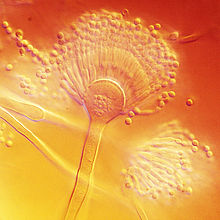| Aspergillus terreus | |
|---|---|

| |
| Scientific classification | |
| Domain: | Eukaryota |
| Kingdom: | Fungi |
| Division: | Ascomycota |
| Class: | Eurotiomycetes |
| Order: | Eurotiales |
| Family: | Aspergillaceae |
| Genus: | Aspergillus |
| Species: | A. terreus
|
| Binomial name | |
| Aspergillus terreus | |
Aspergillus terreus, also known as Aspergillus terrestris, is a fungus (mold) found worldwide in soil. Although thought to be strictly asexual until recently, A. terreus is now known to be capable of sexual reproduction.[2] This saprotrophic fungus is prevalent in warmer climates such as tropical and subtropical regions.[3] Aside from being located in soil, A. terreus has also been found in habitats such as decomposing vegetation and dust.[4] A. terreus is commonly used in industry to produce important organic acids, such as itaconic acid and cis-aconitic acid, as well as enzymes, like xylanase.[3] It was also the initial source for the drug mevinolin (lovastatin), a drug for lowering serum cholesterol.
Aspergillus terreus can cause opportunistic infection in people with deficient immune systems. It is relatively resistant to amphotericin B, a common antifungal drug.[5] Aspergillus terreus also produces aspterric acid and 6-hydroxymellein, inhibitors of pollen development in Arabidopsis thaliana.[6]
In 2023, Australian scientists discovered the ability of A. terreus to decompose polypropylene plastic completely in 140 days.[7]
- ^ Thom C, Church M.B. (1918). "Aspergillus fumigatus, A. nidulans, A. terreus n. sp. and their allies". American Journal of Botany. 5 (2): 84–104. doi:10.2307/2435130. JSTOR 2435130.
- ^ Arabatzis M, Velegraki A (2013). "Sexual reproduction in the opportunistic human pathogen Aspergillus terreus". Mycologia. 105 (1): 71–9. doi:10.3852/11-426. PMID 23074177. S2CID 9584227.
- ^ a b "Fungal Infections Aspergillus terreus". Leading International Fungal Education. Archived from the original on 2 December 2013. Retrieved 13 October 2013.
- ^ "Aspergillus terreus". University of Minnesota. Archived from the original on 23 September 2015. Retrieved 13 October 2013.
- ^ "Aspergillus terreus". Doctor of Fungus. Archived from the original on 3 December 2013. Retrieved 14 October 2013.
- ^ Shimada, A; Kusano,M; Takeuchi,S; Fujioka,S; Inokuchi,T; Kimura, Y (2002). "Aspterric acid and 6-hydroxymellein, inhibitors of pollen development in Arabidopsis thaliana, produced by Aspergillus terreus". Journal of Biosciences. 57 (5–6): 459–464. doi:10.1515/znc-2002-5-610. PMID 12132685. S2CID 37714214.
- ^ Tran, Danny (14 April 2023). "Plastic-eating backyard fungi discovery boosts hopes for a solution to the recycling crisis". Australian Broadcasting Corporation News. Retrieved 26 April 2023.